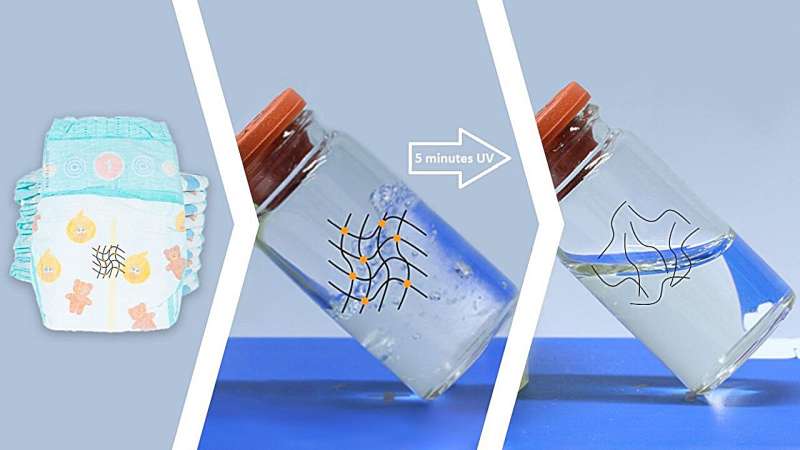This article has been reviewed according to Science X's editorial process and policies. Editors have highlighted the following attributes while ensuring the content's credibility:
fact-checked
peer-reviewed publication
trusted source
proofread
Diapers can be recycled 200 times faster with light

More than 100,000 tons of diapers are disposed of annually in Germany. Vast amounts of valuable resources, such as diaper liners, end up in the trash. The liners consist of special polymers, so-called superabsorbers.
Researchers of Karlsruhe Institute of Technology (KIT) have now succeeded in improving their complex recycling process. They use UV radiation to degrade the chemical chains that keep the polymers together. No chemicals are needed. Recycling at room temperature is 200 times faster than conventional recycling. The recycled polymers can then be processed to new adhesives and dyes. The findings are reported in ACS Applied Materials & Interfaces.
Superabsorbers can be found in diapers as well as in a number of other hygiene and medical products, such as bandages and dressing materials. So far, strong acids have been required to recycle sodium polyacrylate, the highly absorbent material. These crosslinked polymers are insoluble in water.
At high temperature, they do not melt, but only degrade. The acids, however, "cut" the chains stabilizing the polymers after about 16 hours at 80° Celsius and, hence, enabled recycling. This process is complex and expensive, which is why superabsorbers have hardly been reused. Annually, about two million tons of them end up in the trash or are incinerated.
Liquid in five minutes instead of 16 hours
Researchers from the Institute of Biological and Chemical Systems, the Institute for Biological Interfaces, and the Institute for Chemical Technology and Polymer Chemistry of KIT have now found that the cross-linked sodium polyacrylate polymers degrade under UV light after the uptake of water.
"The chains that link the polymers are broken by the light. Then, they are so loose that they swim in water and turn into liquid fibers," Pavel Levkin, Professor at the Institute of Biological and Chemical Systems, explains.
For their studies, the researchers cut out the liners from conventional diapers, wetted them with water, and exposed them to a lamp of 1000 W. After five minutes already did the solid material turn into a liquid that dropped into a collector. "This method with UV light is about 200 times faster than with acids," Levkin says.
The team then used known processes to convert the liquid into new adhesives and dyes. "The observation that the substance is soluble and processible was of high importance. Most probably, it can be turned into many other products," the scientist explains.
For their tests, the researchers used clean diapers. But it is also possible to separate the superabsorbers from used diapers. "Hence, there is no reason why close-to-reality use should not be possible," Levkin says.
The recycling method can be optimized ecologically at no cost by using solar power. "We have found a promising strategy for recycling superabsorbers. This will significantly reduce environmental pollution and contribute to a more sustainable use of polymers."
More information: Shuai Li et al, Diapers to Thickeners and Pressure-Sensitive Adhesives: Recycling of Superabsorbers via UV Degradation, ACS Applied Materials & Interfaces (2023). DOI: 10.1021/acsami.3c06999
Journal information: ACS Applied Materials and Interfaces
Provided by Karlsruhe Institute of Technology





















